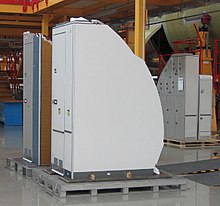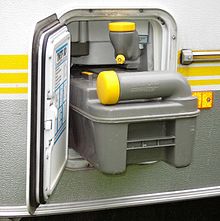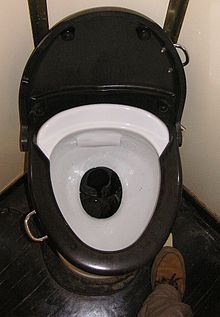On-board toilet
An on- board toilet is a toilet on board vehicles ( aircraft , ships , road vehicles such as mobile homes , coaches or rail vehicles ). Initially, open systems (e.g. downpipe system, marine toilet) were used to discharge the faeces into the environment. With increasing environmental awareness, closed systems are now almost exclusively used, which enable the targeted disposal of faeces. In addition to fixed tank systems, exchangeable tank or cassette toilets are also used. There are different types of faeces processing (hackers, flushing systems, chemical additives) to facilitate storage in the vehicle. Despite the availability of environmentally neutral systems in all applications, systems that are harmful to the environment (chemical toilets) are still used in some cases. Future developments even go beyond environmental neutrality: the on-board (preliminary) clarification can even reduce the burden on the environment.
plane
In aircraft (and other aircraft, such as airships ), closed systems are used which are optimized for the lowest possible storage volume and weight, but which provide sufficient capacity for the duration of the flight. Commercial aircraft have on-board toilets as a closed space (cabin). In the case of aircraft, the on-board toilet is understood to mean the entire toilet space built for the respective aircraft. Toilets are also built into fighter jets with a long range and thus a long flight time, but they are not in the shape of a cabin.
Vacuum toilet
The toilet in aircraft works with water and negative pressure . The water is used to loosen adhering substances from the Teflon-coated toilet bowl and to ensure that it is transported to the central collection tank. The negative pressure for transport is created on the ground and at a low altitude by a fan , at a higher altitude the differential pressure of the pressure cabin is sufficient. As a result, a minimal amount of storage is achieved in an even larger tank which is arranged further away from the toilet bowl. This is emptied at the destination and the content is disposed of there . Chemical additives prevent the stored goods from sticking in the tank and allow the tank to be completely emptied.
Toilet cubicle
Due to the different fuselage cross-sections, the toilet cubicles are structurally different from one another. What they all have in common, however, is that they are seldom designed to be handicapped accessible. Today's on-board toilets use a red or green light to indicate to passengers whether they are free or occupied. This light is placed so that passengers can see it from their seats. Sinks , mirrors and paper towels are usually available in on-board toilets .

Environmental aspects of the aircraft toilet
The fixed tank storage of the faeces used together with relatively little rinse water requires the addition of small amounts of putrefaction-reducing chemicals (usually colored blue). In the event of a technical defect, an uncontrolled exit can occur during the flight. The so-called “blue ice” is created on the outside of the aircraft. During the approach to landing, the aircraft comes into warmer layers of air, which means that the ice block can thaw and fall off. This usually happens near larger airports and can cause damage if you fall down. If people are hit by the ice blocks, which weigh several kilograms, injuries can occur that can be potentially fatal. Some aircraft cabin outfitters have experimented with building small wastewater treatment plants that remove the water from the wastewater and thus create a wastewater cycle. However, the installation of such a system was not approved by the European Aviation Safety Agency , which is why the Airbus A380s from Emirates , which are the only scheduled aircraft with showers on board, have to carry around half a ton of additional water.
Road vehicle
Fixed tank systems are less common in road vehicles ( caravans , mobile homes , buses) due to the more frequent emptying of the on-board toilet. In most cases, therefore, interchangeable tank systems are used that allow individual installation in individual sanitary rooms.
Cassette toilet
The cassette toilet implements an exchangeable tank in the form of a removable faecal cassette. Here, the feces are stored with a very small amount of flushing water in a cassette arranged under the toilet directly during use. The cassette is only opened for toilet use and for emptying via appropriately attached mechanisms and is otherwise tightly closed. For emptying, the cassette can be taken from the outside of the vehicle's toilet system and emptied through the corresponding opening with a spout. Contact with the faeces is thus avoided even when the cassette is emptied.
The size of the cassette is limited by the design of the cassette in the base of the toilet bowl.
A special design of the cassette toilet is the mobile toilet, which is a portable unit with a flush tank in the upper part of the toilet bowl and a faeces cassette in the lower part.
For the proper emptying of the cassettes, special spouts for cassettes are offered (almost always on campsites, often on parking spaces for recreational vehicles, not infrequently also at petrol stations or provided by the municipalities). There are probably no environmental concerns against emptying cassettes without chemical additives in public toilets that are not intended for this purpose; However, these do not have the additional equipment required for hygienic reasons to remove contamination (splashing).
Two systems are used to avoid odors when the cassette toilet is in operation:
Cassette toilet with chemical additives ( chemical toilet )
Before use, a chemical liquid is placed in the empty cassette to prevent the putrefaction process. This is to avoid the formation of odors when the cassette is opened. However, certain chemical additives turn the faeces into hazardous waste, which can seriously impair the functioning of sewage treatment plants ( disposal as hazardous waste ).
However, more and more biodegradable additives in liquid and solid form are gaining acceptance (partly certified with the “ Blue Angel ”), which however require the container to be emptied more frequently. It is not uncommon for additives according to their own recipes (from vinegar to soft soap) to be added.
The chemical additives themselves as well as their disposal, which may be subject to a charge (especially when using environmentally incompatible products) cause operating costs.
Cassette toilet with ventilation and filter
Here an electric fan is switched on through the opening of the cassette to use the toilet, which discharges the putrefactive gases in the cassette to the outside through an odor filter (activated carbon filter). This prevents odors from getting inside the vehicle. The activated carbon filter largely prevents odor nuisance to the outside. The odor filter must be replaced after a long period of use (depending on the intensity of use).
Environmental aspects of the cassette toilet
Aggressive, strongly biocidal chemical additives (such as bronopol or formaldehyde ) have fallen into disrepute. Their disposal is problematic, only possible to a limited extent and is not always carried out properly. This is particularly serious when smaller biological sewage treatment plants cease to function due to chemical additives. This can be avoided by switching to environmentally friendly products that are offered everywhere.
Forced vented cassette toilets are currently still relatively rare. The better environmental compatibility, the simpler and more frequent disposal option of an additional-free toilet cassette as well as the elimination of the costs for chemical additives can justify the currently higher procurement costs (retrofitting of the forced ventilation).
Rail vehicle
For over a hundred years, downpipe toilets were installed in (European) rail vehicles, which were used to dispose of faeces from the moving train onto the rails, with some significant effects on properties adjacent to the railroad (e.g. when used while crossing bridges) , therefore the use of such toilets is also forbidden when the train stops at stations . Such vehicles have not yet been completely withdrawn from circulation. Railway administrations in peripheral European countries ( Great Britain , the Netherlands ) in particular continue to use such vehicles, but trains with downpipe toilets are still in operation in Germany and Switzerland. In addition to the environmental aspect, such toilets are also unsuitable for trains with higher speeds (200 km / h and more), since their wagons have to be pressure-proof , which rules out an open downpipe.
State of the art (2010) is the simple closed toilet system. The negative pressure for sucking off and pumping the black water is generated by means of a single or multi-stage ejector. Gray and black water are collected in a common tank that has to be emptied in short cycles (usually every 3 days).
To extend the emptying cycles to up to 3 months, a closed toilet system with a bioreactor is installed in new trains (e.g. DTZ RABe514 , FLIRT , Integral ). The waste water passes through a filter that is installed inside the solids container and holds back the solid components. In internal systems, the mechanically cleaned wastewater seeps gravitationally into the liquid reactor below. Air enters the liquid reactor through aerator tubes and flows through the so-called fixed bed zone on which a biofilm has grown. After a defined dwell time, the biologically treated liquid is fed into a downstream thermal sanitization unit, where pathogenic germs are destroyed by heating. The prepared liquid is dispensed in defined batches onto the track structure while driving. A leakage of liquid when the vehicle is stationary is prevented, but the use of the toilet is possible without restriction.
ship
Water protection
The international convention for the prevention of marine pollution from ships (MARPOL) regulates the discharge of ship wastewater in Annex IV. Accordingly, the discharge of waste water from ships is generally prohibited. Exceptions apply if the ship has its own sewage treatment plant or if the distance to the nearest coast is at least 12 nautical miles. Wastewater and faeces must be collected in a waste water tank or holding tank and may only be disposed of on the high seas.
Discharge of wastewater is generally prohibited on inland waterways.
Oceans are increasingly being placed under nature protection and the discharge of waste water is generally prohibited:
| Waters | Ban since |
|---|---|
| Baltic Sea | April 12, 2008 |
Wastewater and faeces must be collected in a waste water tank or holding tank. They may only be disposed of in the port using a special excrement suction system. Such systems can be found in every port and most marinas in the Baltic Sea on the German coast .
According to Section 6b (3) of the Ship Safety Ordinance, the rule does not apply to ships
1. that were built before January 1, 1980,
2. that were built before January 1, 2003 and
a) have a hull length of less than 11.50 m or a width of less than 3.80 m
or
b) to whom the Federal Maritime and Hydrographic Agency has issued a certificate of exemption from the equipment requirement
or
c) who have a chopping machine in the toilet that shrinks the waste.
Marine toilet
The so-called marine toilet has been in use for decades, a toilet with a hand pump that conveys seawater as rinse water via a suction pipe and pumps it directly into the sea together with the faeces. A valve is used to switch between “flushing and pumping out” (to continuously pump out the faeces) and “pumping only” (to completely empty the basin and close the flushing water supply). Large amounts of toilet paper or tampons and sanitary towels are problematic, they quickly lead to constipation. For safety reasons, both the supply line for sea water and the thicker waste water line are each provided with a sea valve directly on the ship's side . These valves are closed during travel and when leaving the ship in port in order to prevent water from entering and thus sinking of the ship in the event of a hose rupture.
Holding tank
Modern ships are equipped with an additional holding tank (dirty water tank) in which sewage and faeces are collected. A switch valve is installed between the on-board toilet and the holding tank, which can be used to choose whether the wastewater is pumped into the holding tank or into the sea. A carbon filter between the holding tank and the outboard vent prevents unpleasant odors.
On inland waterways, pleasure craft with a toilet must be equipped with a holding tank and a closed sewage system. There is currently only compulsory conversion for old pleasure craft on inland waters.
The faeces are pumped out via a faeces suction system in the port and fed into the public sewer system.
The problem is the limited space in a ship's hull, which often does not provide space for additional tank installation. The tank is therefore made as small as possible, or the amount of flush water is reduced as much as possible. A vacuum toilet , as it is also used in aircraft, drastically reduces the water requirement, but requires an electric drive, which in turn consumes the electrical energy that is limited on sailing ships.
Sewage treatment plant on larger ships
On larger ships - in addition to the above. Systems - often with their own sewage treatment plant , which clears the faeces from the tank and directs the treated water into the sea after the treatment process. There is no environmental damage here.
Spaceships
In spaceships, on the one hand, the available water must be handled very carefully and, on the other hand, the toilet must also function in weightlessness .
Web links
Individual evidence
- ↑ Chunks of ice from the sky (PDF; 95 kB), information from the Federal Aviation Office of March 11, 2010
- ↑ Warm rain for millionaires . Mirror online. July 31, 2008. Retrieved January 8, 2017.
- ↑ Art. 2 and 4 of the ordinance of 9 April 2008 ( Federal Law Gazette I p. 698 )





